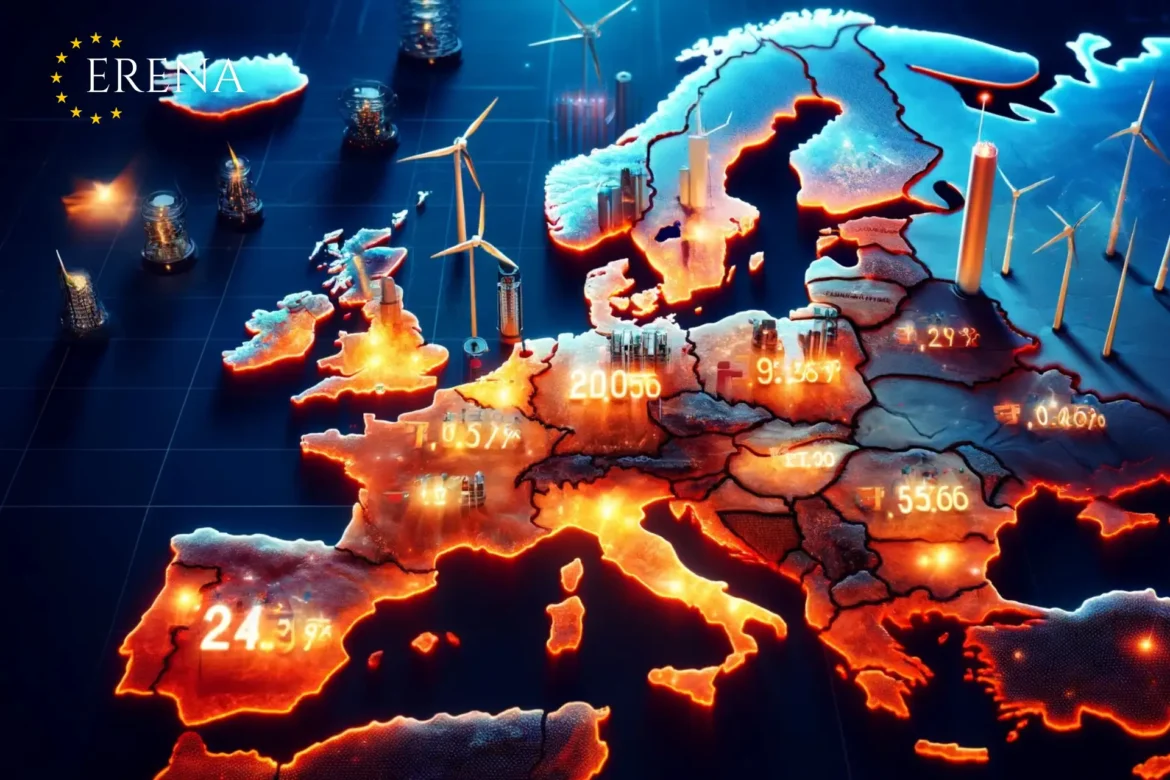At the beginning of 2025, electricity prices in European countries continue to show significant fluctuations due to various economic and natural factors. The key reasons for these changes include weather conditions, the level of renewable energy generation, market demand fluctuations, and government regulatory mechanisms.
General Overview of the Electricity Market
The European electricity market is characterized by high volatility due to its dependence on gas supplies, nuclear power plant operations, and wind energy production. In recent years, the gradual transition to renewable energy sources (RES) has had a considerable impact on the market, leading to significant price fluctuations. Additionally, the carbon quotas imposed by the European Union and climate policies also affect electricity production costs.
Country-Specific Price Analysis
Germany
Germany, one of Europe’s largest economies, saw electricity prices fluctuate widely in January 2025. The average price stood at €113.91 per MWh, but on January 12, there was a sharp increase to €936 per MWh. This surge was caused by a decline in wind energy generation, which led to increased demand for conventional energy sources such as gas and coal. Additionally, extra costs associated with CO₂ emissions influenced the price.
Germany’s electricity market has become increasingly dependent on gas supplies in recent years. Following the energy crisis of previous years, German authorities have taken measures to expand renewable energy sources, yet energy supply stability remains a concern.
France
France continues to rely on nuclear energy, allowing it to maintain relatively stable prices. In January 2025, the average electricity cost in France ranged from €65.59 to €71.40 per MWh. Thanks to high nuclear power plant productivity and the active development of wind energy, France avoided the sharp price spikes observed in other countries.
However, several factors, such as seasonal maintenance work on nuclear plants and weather conditions, could affect future trends. Additionally, France actively exports electricity to neighboring countries, which may influence national tariffs at certain times.
Spain and Italy
In Southern European countries such as Spain and Italy, electricity price fluctuations were particularly pronounced. In Spain, electricity prices ranged from €21.79 to €140.68 per MWh, while in Italy, they varied between €126.26 and €192.84 per MWh. The main reasons for these fluctuations include dependence on gas imports, wind energy instability, and weather conditions.
Solar energy plays a crucial role in these countries, but its generation is significantly lower during the winter, leading to increased demand for alternative energy sources. Moreover, both the Italian and Spanish markets face high costs for carbon quotas, which also impact the final electricity prices for consumers.
United Kingdom
In the United Kingdom, the average electricity price in January 2025 ranged from £92.90 to £106.20 per MWh. Several factors influenced the market, including electricity imports from Europe, gas-fired power plant production levels, and weather conditions. Despite an increase in wind energy capacity, the country remains highly dependent on conventional sources, especially during winter months.
The UK continues its efforts to reduce CO₂ emissions, which affects electricity costs. Increased investment in renewable energy is expected to lower prices in the long term, but in the short term, price fluctuations remain significant.
Key Factors Affecting Prices
1. Renewable Energy Development – The share of RES in the European energy system is growing, but their instability (dependence on weather) leads to sharp price spikes during low generation periods.
2. Weather Conditions – Winter months see increased electricity consumption, putting pressure on conventional energy sources and driving prices up.
3. Carbon Quotas and Government Regulations – CO₂ emission restrictions raise electricity costs, particularly in countries where a significant portion of energy is generated from fossil fuels.
4. Electricity Imports and Exports – Countries that heavily import electricity are affected by price trends in neighboring nations. Exports also play a role in shaping domestic tariffs.
5. Gas Prices – Gas remains a crucial energy carrier, and its cost directly impacts electricity tariffs.
Forecast for 2025
The European electricity market is expected to remain volatile throughout 2025. The development of renewable energy sources should mitigate the impact of weather conditions, but their generation instability will continue to cause price fluctuations. European governments are implementing measures to stabilize the market, but reliance on gas and global energy trends remain key factors.
In the long term, electricity prices are expected to decrease as renewable energy generation increases and dependence on traditional hydrocarbons decreases. However, in the short term, consumers should be prepared for fluctuating tariffs, particularly during extreme weather conditions.
In conclusion, January 2025 confirmed that electricity prices in Europe remain unpredictable. The main challenges stem from renewable energy generation instability and dependence on gas imports. Therefore, both governments and consumers should closely monitor developments and adjust their energy consumption strategies accordingly.
Electricity Prices in European Countries for January 2025
658

